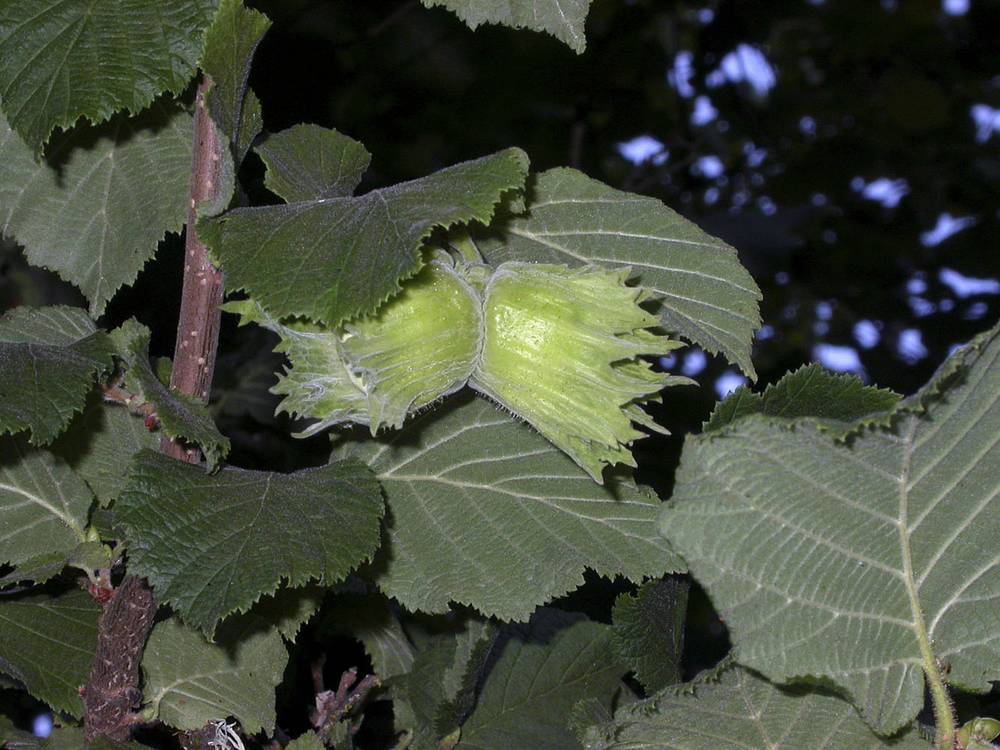
Plants 3–5 m.
Leaves blades 70–105 × 60–99 mm, dark green above, green beneath, bases narrowly cordate, margins with 4–6 coarse triangular or acuminate teeth mostly in distal half and 2 orders of fine sharp serration around whole margin, tips abruptly short-acuminate, abaxially soft-pubescent, felty to the touch, surfaces adaxially sparsely pubescent, smooth to the touch; petioles 8–19 mm, pubescent with spreading simple, glandular and non-glandular hairs, glandular hairs much > non-glandular hairs.
Staminate catkins sometimes solitary, usually 2–4 on a short leafless twig from bud of previous year’s growth, 25–55 × 4–5 mm.
Fruits usually 2–3 clustered at tips of twigs, ovoid or subspherical, 10–15 × 10–15 mm, brown; bracts separate, deeply laciniate, 12–17 mm, loosely surrounding nut, ? nut and not concealing it, finely canescent.
Riparian woodlands, pond shores. Flowering Jan–Mar. 0–200 m. WV. WA; north to British Columbia; southwestern Asia, Europe. Exotic.
Corylus avellana is an important commercial crop in Oregon. It is grown for its nuts, known as hazelnuts or filberts. Over 99% of the hazelnuts produced in the United States are grown in the Willamette Valley. Most of the world supply, however, comes from Turkey. Two other Eurasian species are important in the hazelnut industry. The Turkish hazel, C. colurna, has a longer petiole, and the involucre, which is covered with bristly glandular hairs, is lacerate almost to its base into lanceolate lacinae that have many sharp, lanceolate lateral teeth. It is a tree up to 10 m tall, and it does not sucker from the roots, so it has a single trunk (sometimes 2 or 3 trunks arising from the same point). Because it doesn’t sucker, it is widely used as a rootstock for grafting commercial hazels. Corylus maxima, a suckering shrub, has a long tubular involucre, somewhat like the native C. cornuta but scarcely contracted above the nut. Some commercial hazelnut cultivars are hybrids between C. avellana and C. maxima. All three of these species (C. avellana, C. colurna, and C. maxima) are susceptible to the fungus Anisogramma anomala, known as eastern filbert blight. This fungus, native to the eastern United States, was introduced to Oregon in the late twentieth century.
as described under Corylus avellana
Shrubs , broadly spreading, to 5(--8) m. Bark coppery brown, smooth, sometimes exfoliating in thin papery strips. Branches ascending; twigs pubescent, covered with bristly glandular hairs. Winter buds containing inflorescences ovoid, 5--6 × 3--4 mm, apex obtuse. Leaves: petiole pubescent, covered with bristly glandular hairs. Leaf blade broadly ovate to broadly elliptic, often nearly angled to lobulate near apex, 5--12 × 4--12 cm, moderately thin, base narrowly cordate to narrowly rounded, margins coarsely and doubly serrate, apex abruptly acuminate, abaxially sparsely to moderately pubescent, velutinous to tomentose along major veins and in vein axils. Inflorescences: staminate catkins lateral along branchlets on relatively long short shoots, usually in clusters of 2--4, 3--8 × 0.7--1 cm; peduncles mostly 5--12 mm. Nuts in clusters of 2--4; bracts much enlarged, distinct nearly to base, expanded, shorter than to only slightly longer than nuts, apex deeply lobed; bract surfaces pubescent. 2 n = 22, 28.Flowering very early spring. Abandoned plantings, roadsides, thickets, waste places; 0--700 m; introduced; B.C.Corylus avellana is widely grown as an ornamental shrub in temperate North America, and it sometimes persists following cultivation, although it seldom becomes established.Corylus avellana is similar to C . americana in habit, leaves, and fruit characteristics, although it becomes much larger. If fruits are present, the two species can be distinguished by the involucre, which is shorter than the nut in C . avellana . The best technical character for separating these species in the absence of fruits is the length of the peduncles of the staminate catkins (which are formed during the summer prior to the season of blooming).